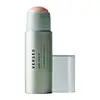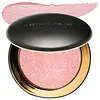What's inside
What's inside
 Key Ingredients
Key Ingredients

 Benefits
Benefits

 Concerns
Concerns

 Ingredients Side-by-side
Ingredients Side-by-side

Caprylic/Capric Triglyceride
MaskingCoco-Caprylate/Caprate
EmollientOctyldodecanol
EmollientCaprylic/Capric/Myristic/Stearic Triglyceride
EmollientPentaerythrityl Adipate/Caprate/Caprylate/Heptanoate
EmollientHelianthus Annuus Seed Wax
Skin ConditioningMica
Cosmetic ColorantC10-18 Triglycerides
EmollientPolyhydroxystearic Acid
EmulsifyingStearyl Behenate
EmollientSimmondsia Chinensis Seed Oil
EmollientDiisostearyl Malate
EmollientDicalcium Phosphate
AbrasiveSynthetic Fluorphlogopite
Stearalkonium Hectorite
Gel FormingSilica
AbrasivePolyglyceryl-2 Triisostearate
EmulsifyingSorbitan Isostearate
EmulsifyingSilica Silylate
EmollientPropylene Carbonate
SolventIsostearic Acid
CleansingLecithin
EmollientPolyglyceryl-3 Polyricinoleate
EmulsifyingTin Oxide
AbrasiveBlakeslea Trispora Mycelium Extract
CI 77891
Cosmetic ColorantCI 77491
Cosmetic ColorantCaprylic/Capric Triglyceride, Coco-Caprylate/Caprate, Octyldodecanol, Caprylic/Capric/Myristic/Stearic Triglyceride, Pentaerythrityl Adipate/Caprate/Caprylate/Heptanoate, Helianthus Annuus Seed Wax, Mica, C10-18 Triglycerides, Polyhydroxystearic Acid, Stearyl Behenate, Simmondsia Chinensis Seed Oil, Diisostearyl Malate, Dicalcium Phosphate, Synthetic Fluorphlogopite, Stearalkonium Hectorite, Silica, Polyglyceryl-2 Triisostearate, Sorbitan Isostearate, Silica Silylate, Propylene Carbonate, Isostearic Acid, Lecithin, Polyglyceryl-3 Polyricinoleate, Tin Oxide, Blakeslea Trispora Mycelium Extract, CI 77891, CI 77491
Caprylic/Capric Triglyceride
MaskingOctyldodecanol
EmollientMica
Cosmetic ColorantSimmondsia Chinensis Seed Oil
EmollientSilica
AbrasiveCera Alba
EmollientHelianthus Annuus Seed Wax
Skin ConditioningCalcium Sodium Borosilicate
Aroma
Octyldodecyl Myristate
EmollientCapparis Spinosa Fruit Extract
Skin ConditioningEthylhexyl Palmitate
EmollientDimethylmethoxy Chromanol
AntioxidantTrihydroxystearin
Skin ConditioningSodium Hyaluronate
HumectantTin Oxide
AbrasiveCI 77891
Cosmetic ColorantIron Oxides
CI 75470
Cosmetic ColorantCaprylic/Capric Triglyceride, Octyldodecanol, Mica, Simmondsia Chinensis Seed Oil, Silica, Cera Alba, Helianthus Annuus Seed Wax, Calcium Sodium Borosilicate, Aroma, Octyldodecyl Myristate, Capparis Spinosa Fruit Extract, Ethylhexyl Palmitate, Dimethylmethoxy Chromanol, Trihydroxystearin, Sodium Hyaluronate, Tin Oxide, CI 77891, Iron Oxides, CI 75470
Ingredients Explained
These ingredients are found in both products.
Ingredients higher up in an ingredient list are typically present in a larger amount.
This ingredient is an emollient, solvent, and texture enhancer. It is considered a skin-softener by helping the skin prevent moisture loss.
It helps thicken a product's formula and makes it easier to spread by dissolving clumping compounds.
Caprylic Triglyceride is made by combining glycerin with coconut oil, forming a clear liquid.
While there is an assumption Caprylic Triglyceride can clog pores due to it being derived from coconut oil, there is no research supporting this.
Learn more about Caprylic/Capric TriglycerideCi 77891 is a white pigment from Titanium dioxide. It is naturally found in minerals such as rutile and ilmenite.
It's main function is to add a white color to cosmetics. It can also be mixed with other colors to create different shades.
Ci 77891 is commonly found in sunscreens due to its ability to block UV rays.
Learn more about CI 77891Helianthus Annuus Seed Wax is created from the common sunflower.
Sunflower seed wax is made up of long chain non-glyceride esters, a small amount of fatty alcohols, and fatty acids.
This ingredient is often used to enhance the texture of products. The fatty acid properties also help hydrate the skin.
Learn more about Helianthus Annuus Seed WaxMica is a naturally occurring mineral used to add shimmer and color in cosmetics. It can also help improve the texture of a product or give it an opaque, white/silver color.
Serecite is the name for very fine but ragged grains of mica.
This ingredient is often coated with metal oxides like titanium dioxide. Trace amounts of heavy metals may be found in mica, but these metals are not harmful in our personal products.
Mica has been used since prehistoric times throughout the world. Ancient Egyptian, Indian, Greek, Roman, Aztec, and Chinese civilizations have used mica.
Learn more about MicaOctyldodecanol is a fatty alcohol. It is primarily used to enhance the texture of products.
As an emulsifier, Octyldodecanol helps prevent the oils and waters from separating. It also prevents ingredients from creating foam when shaken.
Octyldodecanol is created by reducing fatty acid to an alcohol.
Due to its high molecular weight, it does not get absorbed into the skin.
Learn more about OctyldodecanolSilica, also known as silicon dioxide, is a naturally occurring mineral. It is used as a fine, spherical, and porous powder in cosmetics.
Though it has exfoliant properties, the function of silica varies depending on the product.
The unique structure of silica enhances the spreadability and adds smoothness, making it a great texture enhancer.
It is also used as an active carrier, emulsifier, and mattifier due to its ability to absorb excess oil.
In some products, tiny microneedles called spicules are made from silica or hydrolyzed sponge. When you rub them in, they lightly polish away dead skin layers and enhance the penetration of active ingredients.
Learn more about SilicaThis oil comes from the seeds of the desert shrub called Jojoba. It is more commonly known as jojoba oil, a non-comedogenic oil.
Jojoba oil does not contain fragrance and has many fatty-acids, making it a great soothing ingredient.
It also contains Vitamin E, a great moisturizing ingredient. Vitamin E is also an antioxidant and protects your skin against oxidative damage.
This ingredient humectant properties, meaning it helps draw moisture from the air. This helps keep your skin hydrated.
While jojoba has antibacterial properties, it is only able to kill some strains of bacteria.
Studies also show it helps in wound healing. In fact, Indigenous cultures have used jojoba as a moisturizer and to help treat burns for centuries.
Fun fact: Jojoba oil similar to natural human skin sebum, so it has a great effect on dry skin. It is also promising with helping to regulate sebum production.
Due to its fatty acid content, Jojoba oil may not be fungal acne safe. We recommend speaking with a professional if you have any concerns.
Learn more about Simmondsia Chinensis Seed OilTin Oxide is an inorganic oxide used to add opacity and volume to a product. In nature, it is already found in mineral form. The main ore of tin is an opaque and shiny mineral called casseterite.
Tin Oxide helps remove translucency in a product, or make it more opaque. Besides adding opacity, tin oxide is used for bulking to add volume.